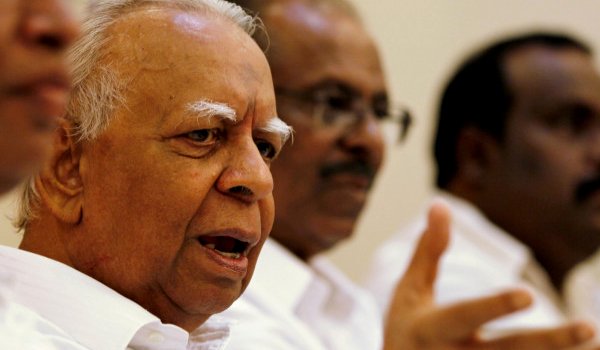R, Sampanthan, Leader of TNA and ITAK – www.seithy.com / 2015 December 23
“Thamil Makkal Peravai” (TMP) prompted this essay on Christmas Day. I checked up on the English translation of the Tamil word “Peravai” with a few Tamil friends and there were at least 03 suggestions. One said it’s a “Council”. Another said it’s a “Front” while the third suggested the word “Platform”. A council, front or platform, this new collective of Northern and Eastern politicos and concerned social activists formed during the previous weekend, certainly has an anti TNA projection. Together with Northern Province Chief Minister C.V. Wigneswaran simply introduced as Justice C.V. Wigneswaran, Dr. P Lakshman a Senior Cardiologist at the Teaching Hospital, Jaffna and T. Vasantharajah, Secretary of the Batticaloa Civil Society as Co-chairs in this brand new formation “Thamil Makkal Peravai”, they all sound frustrated with TNA politics and its leadership, since President Maithripala Sirisena’s ascent to Sinhala political leadership in late 2014, against former President Rajapaksa.
The Rajapaksa rule was horrible in many ways in any language. His 09 year rule had two distinct phases. Beginning in year 2006 the first phase geared up to wage war against what it called “Separatist terrorists” generalised as “Tamil terrorists”. The social ideology created for that war was a broad “anti-Tamil” Sinhala ideology sponsored by the Rajapaksa leadership with a partly coerced, partly willing Colombo based mainstream media. The JVP and the JHU worked overtime for him on this war project that wanted Tamil “separatism” eliminated at any cost. That did happen after 03 years, in May 2009. This first phase under emergency regulations and the PTA in force carries with it all violations of law, packed with everything indecent and savage in a civilised human society. This first phase that has on record many cases of abductions and enforced disappearances concluded with the mysterious disappearance of Ekneligoda in January 2010.
His second phase in power began after the two back to back elections in 2010; Presidential elections in January and the Parliamentary polls in April. The passage of the 18th Amendment allowed without a Referendum by then Chief Justice Shiranee Bandaranayake gave him absolute power. This second phase has only a single abduction with one Sunil from Wanathamulla abducted and dropped off in Dematagoda over protests against demolition of slum houses. The second phase is all about unbelievably heavy nepotism, mega plunder of public funds and national wealth under a Sinhala “Al Capone” tolerated and accommodated especially by the urban middle class.
Conclusion of the war that led to this “Al Caponic” second phase was a multiple national tragedy. Although it eliminated the LTTE, it left Tamil society completely uprooted and dismantled without a political alternative to the absent LTTE. In the South it allowed the Rajapaksa regime to continue with a militarised Sinhala State accepted without qualms. The UNP and the JVP backed by so called “democratic” voices in urban Sinhala middle class chose to run Gen. Fonseka as their own “war hero” for the 2010 January presidential election thus endorsing militarisation. It is in such context the TNA was expected to politically fill the void in North-East and face a Sinhala “Al Capone” that lived on a Sinhala supremacist social psyche.
That was no easy challenge; complex and immense. The TNA had to start its campaign for immediate humanitarian aid, resettlement with dignity, rehabilitation of ex-LTTE “surrenders”, release of all detainees without charges and early and quick judicial procedure to be in place for suspected LTTE cadres with charges and finally reconciliation and a consensual political solution for power sharing. Meanwhile there was lobbying by Tamil Diaspora groups for international intervention for investigation of “war crimes”, a UN sponsored “referendum” and a “Thamil Eelam” cried out loud by fringe Tamil Nadu groups; all out of the orbit for a decimated Tamil society groping to once again have a foothold in life.
What gave the TNA an opportunity to push through its presence in local Tamil politics initially was international pressure from West that Rajapaksa in a way invited against him. His open and direct posturing with China was problematic, especially for the US. His very apparent ridicule of the West on the strength of China and Putin’s Russia to some extent provoked the UNHRC Resolutions on Sri Lanka. With international pressure thus conspired by the US and the Tamil Diaspora adding to it, resettlement of the displaced with basics were effected within a year though under military supervision. Rehabilitation was also quickened. Then came local government elections in March and July 2011 that became the first post war opportunity for the TNA to politically address the Northern and Eastern Tamil people. With a resounding win at the LG elections, the TNA became the accepted “Tamil voice” in Sri Lankan politics. CHOGM in November 2013 was when the TNA had its first major opportunity to press home its agenda for all reforms and remedies for especially the Tamil people in the North and also for the North and East as a whole. What is now being assessed is its performance thereafter.
The TNA leadership was no different to the Sinhala leaders in the South in how it engaged with the people. Led by ITAK, its leadership that was bogged down in electoral politics for decades and then having lived a displaced political life for another few decades, the ITAK knows and is only capable of electoral politics. The fundamental error therefore was in not taking the people as the uncompromising strength in all lobbying and negotiations beyond and after elections. Post local government elections in 2011 when the TNA won 32 local government bodies in North and the Vanni with over 255,000 people voting for them, the ITAK leadership thought they could bargain their demands on those numbers. They thus allowed the collective strength of those numbers to vaporise without making them a mobilised, agitating force. Rajapaksa too was happy that way. He could call himself a “democrat” having allowed elections, TNA winning them handsomely and thereafter leaving it at that. Rajapaksa was happy he could sell his LLRC for time buying, with the TNA leadership keeping the affected Tamil society in limbo. Its recommendations including “de-militarising” of North and East and the provincial administration were not demanded by TNA.
The next biggest political blunder of the ITAK leadership came with the Northern PC (NPC) elections when they concentrated heavily in bringing a Chief Ministerial candidate of unquestionable integrity and very high quality all round but paid little heed to a people centred “development programme” that the NPC would ensure implementation for its people on the strength of the people. Instead the TNA leadership left the NPC to linger on without political guidance while they spent time with the Colombo government, New Delhi and other power centres in the West. While they were back to negotiations like “Thanthai” Chelva’s old ITAK, while they were also trying to lobby Indian and international support for demands that were not high up in the agenda of the Northern and the Vanni people who survived the most bloodiest and brutal war in Asia after India helped installAwami League in power in December 1971, followed by wiping off the “Mukti Bahini“, Rajapaksa dropped all offers on a political solution having taken New Delhi on a “merry-go-round” for 04 years. He basically reduced all reconciliation efforts to massive constructions in North and East he called “development” that provided his cronies with huge kickbacks.
Between the NPC elections and the overwhelming victory that proved the TNA could easily bring the Tamil people to demand answers for themselves, people were not taken as a political factor. All attempts at negotiations by the ITAK leadership were wholly dependent on their legal expertise and electoral outlook in politics. People in the North and the East were made to understand the fault was with Rajapaksa’s Sinhala politics with its military rule and not in how the ITAK leadership handled their post war responsibilities. That common perception provided good enough reason for Tamil people to go en bloc against Rajapaksa at the 2015 January presidential elections. In North and the Vanni 76.5% of the people and 72.9% in the East voted for Sirisena, thus ensuring the defeat of Rajapaksa solely on the numbers of Tamil votes. They defeated Rajapaksa cultivating a high expectation the TNA leadership would have a better opportunity in solving their festering problems in North and East.
Immediately after his swearing in as Executive President, Sirisena brought in a UNP dominated government for his promised 100 Day programme. The much-hyped 100 Day programme had nothing for the Tamil people. Not even the words “Tamil” and “Muslims” or “ethnic and religious minorities” were mentioned in it even by accident. Yet the TNA was politically naïve and was not prepared to challenge the 100 Day programme to at least demand inclusion of “de-militarisation” of North-East, release of all Tamil detainees under the Prevention of Terrorism Act (PTA) who for many years have been kept without any charges or even to demand a “Land Dispute Commission” to allow the Tamil people to have legal and official access to their own lands. Instead the ITAK leadership continued to hold out its promise for a total answer to long overdue Tamil problems from this government leadership even after the 100 Day programme was openly flouted and dragged on with very lame excuses. With the forthcoming parliamentary elections in August, Sampanthan addressing Trincomalee TNA members told them, “As far as the TNA is concerned, it does not want to further stretch the journey for a political solution for our people. We want to reach the end to our struggle. Hence the Tamil people must give us an overwhelming victory. If you will give us such a victory, we will definitely find the solutions in the year 2016.” That was in mid July this year. Three months later, the TNA could not even have the 206 Tamil suspects detained without charges released before Diwali. President Sirisena very casually backtracked on his promise given to the TNA leadership in late October and left them helpless.
This “change” that most Colombo middle class is over enthusiastic about is only a “Sinhala” change for the South and nothing more as I argued in an earlier essay titled “Is the Government afraid of ‘Sinhala’ racists or is it racist too?” And there I wrote, “That would therefore leave the hardliners in Tamil politics to question the wisdom of the TNA leadership in backing this government……”. The “Tamil Makkal Peravai” seems just that. Questioning the capability and wisdom of the TNA leadership that seems a failure in advancing the political aspirations of the Tamil people for realistic answers.
Thus the most important question would be to see how the TMP would take over the responsibility of solving problems of the Tamil people entrenched too long in a political quagmire. Will they give the people their due share in political participation to demand answers for their issues? Will they engage democratic Southern groups to storm the streets of Colombo demanding answers from a government that is afraid of Sinhala votes? In short, what is more important is to know how the TMP would differ from the TNA in facing up to this government. Will they garner the strength of the people the TNA never thought of using? Or will they be just a rhetorical “peravai”? The wait, if not too long, will be an interesting wait.
- Kusal Perera
(groundviews.org)






